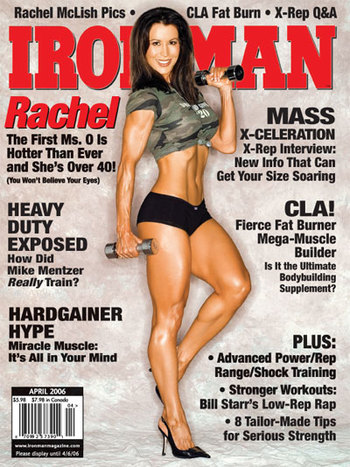Resistance training and lifting weights will produce a few major measurable changes depending on the workout protocol you are following including:

Here is Rachel McLish the first Ms Olympia on the cover of Ironman magazine, over 40 years old looking amazing.
Increased Strength
Increased Endurance
Increased Strength-Endurance
Increased muscle size
Almost any resistance training program will produce some measurable changes in each of these categories. The specific set, rep, and rest scheme will determine to some degree which changes are maximized.
In general terms, as long as you’re lifting weight that is above approximately 40% of your 1-rep max you will be stimulating some degree of muscle adaptation in all of the above mentioned categories.
The specific set and rep ranges you work within coupled with your genetically determined responsiveness will determine how fast and to what degree you will develop in each category.
Some people will react faster than others, some will respond to higher reps vs lower reps, but in general most people will have similar responses in the same rep and set ranges.
The specific sets and reps you choose to do will have less impact on your overall progress than your consistency and intensity.
In other words, working out consistently every week and pushing hard each workout is going to have a much bigger impact than trying to come up with complicated rep and set schemes to follow.
Changing from high to low rep ranges has less of an impact on your physiology than it does on your psychology.
Or said another way, most people just get bored doing the same rep and set ranges too often so they want something to change…but the reality is the same reps and sets can work if you just push through them.
As always the real test of your progress is your VI numbers and how close you are to your ideal VI (or your specific goal, whether that is a look, or performance or a combination of both).
The biggest benefit of mixing up set and rep ranges might just be to fight off boredom and make working out less monotonous and more interesting.
In today’s podcast we discuss sets and reps and the specifics of working out for muscle and if there are differences in men and women when it comes to strength training.
John
LISTEN:
Podcast: Play in new window | Download
OMG!!! This totally rocks!! This is where I’m striving to get to so this PodCast was one I could totally relate to.
Thanks so much,
Hey JB, great post/podcast, as usual…
I’m finally getting around to watching that doc, “Fat Head”, and so far he’s just making the point of calories in vs. calories out… BUT they do make a mention of the ability of hormones to store fat, specifically insulin. And herein lies yet another food myth problem: have you honestly found the “carbs-store-fat” to happen even if you are eating at or less your caloric need for the day? Is there a difference between men and women in this area since our hormones are different?
When I lost 18 lbs, I didn’t exactly swear off sugar or carbs; I just ate them infrequently and kept my eye on everything. ::sigh:: The amount of people telling me I’m unhealthy for eating less… 😉
@Ian, brilliantly put: meds shouldn’t compensate for the effects of overeating.
So many people I know are on meds for things they can change simply through diet and behavior. Psychologists say that some people feel “special” that they need meds to get through the day…just for them…in a little bottle with their name printed on it.